The Sea Peoples terrorized Egypt and the Mediterranean during the Bronze Age, but their identity and origins remain mysterious to this day.

Public DomainThe “Sea Peoples” terrorized Bronze Age civilizations but very little is known about them.
In the 12th century B.C.E., Bronze Age civilizations began to fall like dominoes. The Hittite Empire, the Mycenaean kingdoms, and the Amorite states collapsed entirely; societies in Egypt and Assyria emerged greatly weakened. What caused this collapse? The reasons are myriad, but historians believe that one factor was the “Sea Peoples” — a mysterious and violent society that raided kingdoms across the Mediterranean.
In Canaan, a king wrote about enemies who’d burned cities and done “evil things in my country.” In Egypt, ancient records recalled invaders who “came from the sea in their war ships and none could stand against them.”
So who were the Sea Peoples? They certainly left their mark on the ancient world. But their identity stands as one of the greatest historical mysteries of all time, and scholars debate about their origins to this day.
Who Were The Sea Peoples?
The term “sea people” (peuples de la mer) was first coined by 19th-century French Egyptologists. But the history of Sea Peoples began long before that.
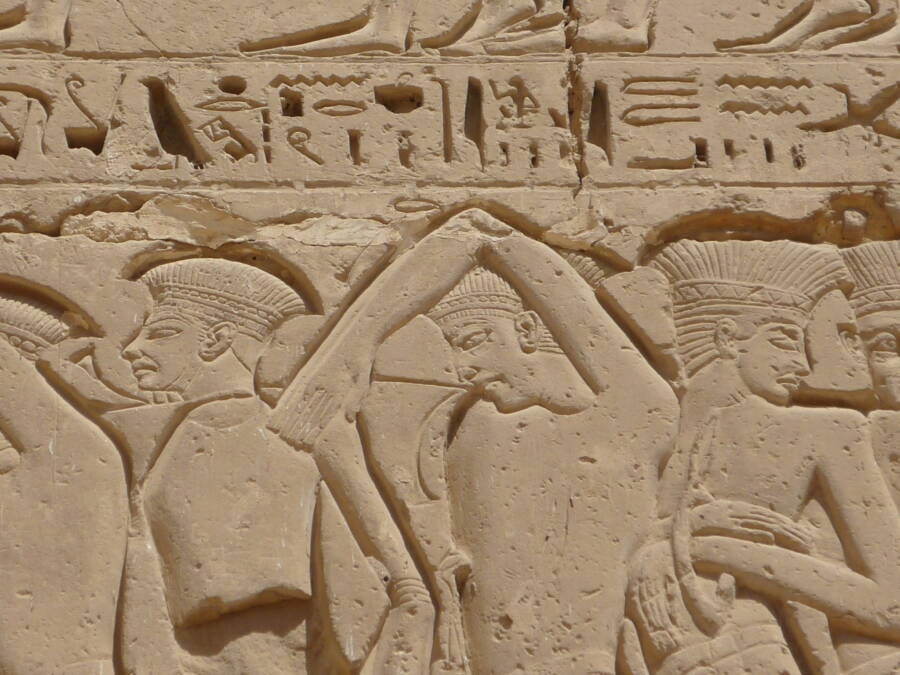
Rémih/Wikimedia CommonsSea Peoples taken captive by Ramesses III, as seen in a relief at the temple of Medinet Habu.
Thirteenth- and 12th-century sources describe several attacks from these oceanic raiders. The Sea Peoples seemingly struck places in Egypt, the Hittite Empire, the Levant, and elsewhere in the Mediterranean. Ancient sources give them various names, including Denyen, Ekwesh, Lukka, Peleset, Shekelesh, Sherden, Teresh, Tjeker, and Weshesh.
So who were the Sea Peoples? Today, no one knows for sure. Their name derives from ancient accounts which refer to them as “from the sea” or from “islands” — though these do not specify which sea or which islands.
But present-day historians have some theories. The Sea Peoples may have come from western Asia Minor, the Aegean, the Mediterranean islands, or Southern Europe. Possibly, they could have been Etruscan, Trojans, Italians, Philistines, Myceans, or Minoans. They may have been driven into the Mediterranean by environmental factors like drought.
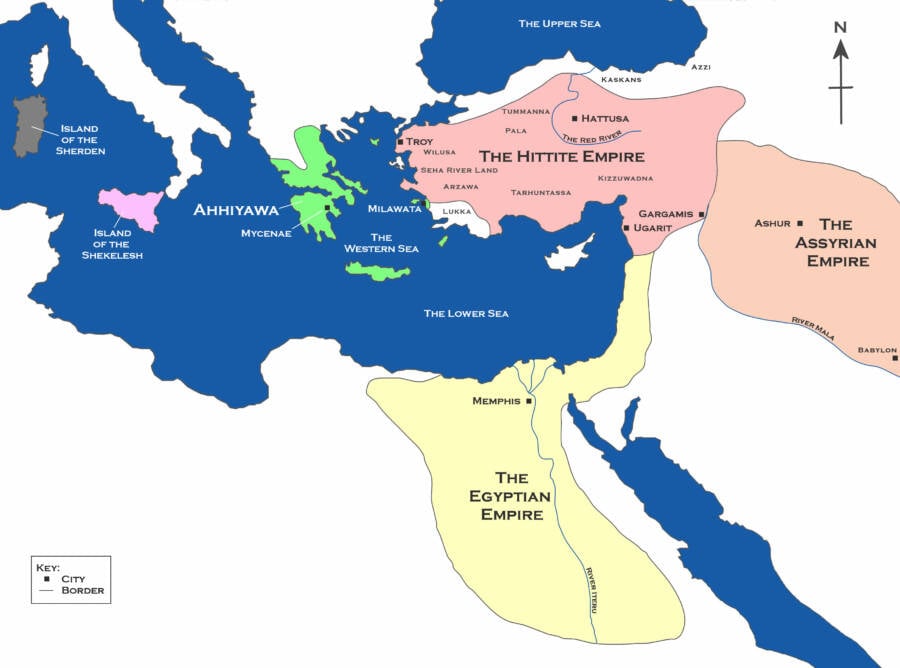
Empires of Bronze/Gordon DohertyA map of the ancient world showing a number of empires that were attacked by the Sea Peoples, including the Egyptians, the Hittites, and the Assyrians.
Sometimes, the Sea Peoples were mentioned as allies, sometimes as mercenaries. But more often than not, they were described as enemies. Curiously, they were also sometimes described more like migrants than soldiers, as their ships were said to carry women, children, and household goods, as if they had hoped to establish permanent settlements.
And whoever they were, they left their mark on the ancient world. As contemporary sources — mostly Egyptian though Hittites and Assyrian as well — record, their attacks were sudden, surprising, and devastating.
‘None Could Stand Against Them’
Most of what we know about the Sea Peoples come from Egyptian accounts, specifically, those written between 13th century B.C.E. and the 12th century B.C.E. during the reigns of Ramesses II (1279-1213 B.C.E), Merneptah (1213-1203 B.C.E), Ramesses III (1186-1155 B.C.E.).
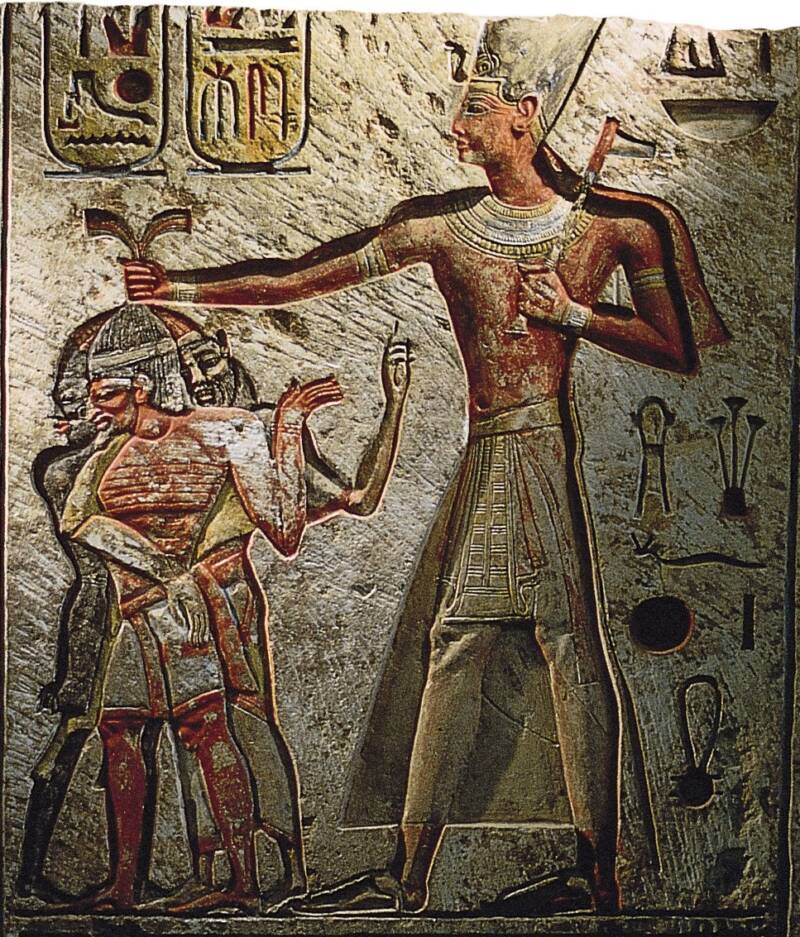
Speedster/Wikimedia CommonsA depiction of Ramses II with conquered enemies. He routed the Sea Peoples during a battle, but they would return to challenge his successors.
One account from Ramses II’s reign describes a battle in 1274 B.C.E. between the Egyptians and the Hittites in which Sea Peoples are described as both Hittite allies and Egyptian mercenaries. Another describes how the Sea Peoples sailed into the Nile Delta, only to be met with Ramses II’s forces. The battle is recorded on the Tanis Stele II, which reads:
“The rebel Sherden, who no one knew how to fight, came courageously sailing from the middle of the sea on their warships, none could stand against them.”
Ramses II neutralized the threat — and conscripted some of the Sherden into his army — but the Sea Peoples continued to harass his successors.
During Merneptah’s reign, the Sea People aligned with the Libyans. The Egyptians described them as coming “from the seas to the north” and dubbed them “Ekwesh, Teresh, Lukka, Sherden, and Shekelesh.”
Merenptah was able to soundly defeat them, an accomplishment he immortalized on the walls of the Temple of Karnak and in his funerary temple at Thebes, which triumphantly declares: “Everyone who travels has been subdued by the King of Upper and Lower Egypt.”
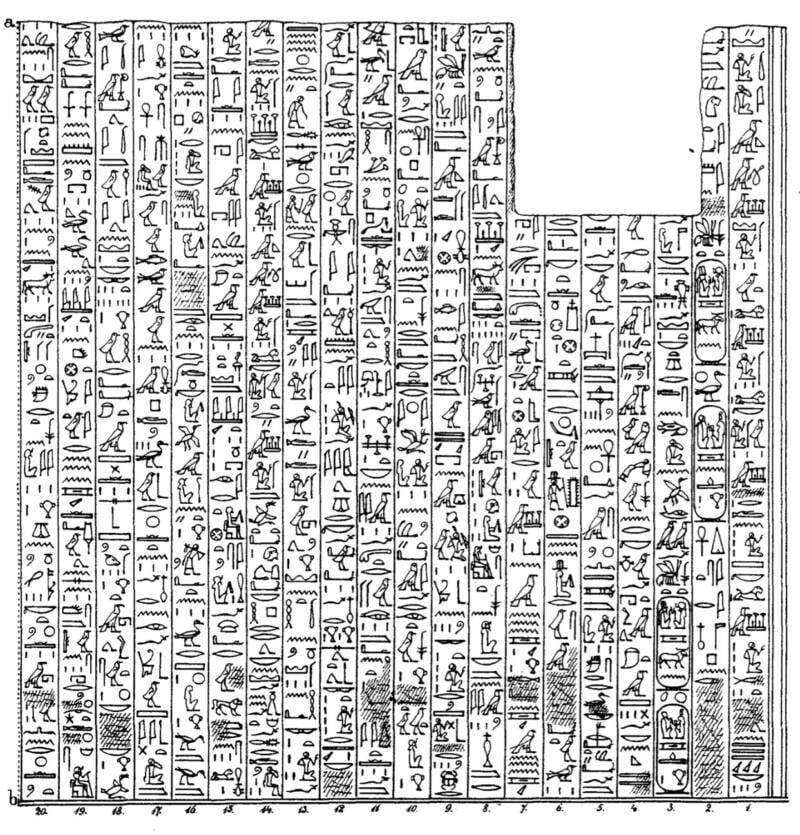
Public DomainThe Great Karnak inscription which includes details about Merenptah’s victory over the Sea Peoples.
Despite this, attacks by the Sea People were also recorded by Merenptah’s successor, Ramesses III. One such attack in around 1175 B.C.E. — and the subsequent Egyptian victory — was recorded in the Medinet Habu in Thebes.
It reads:
“Now the northern countries on their islands were trembling in their bodies. They entered the channels of the mouths of the Nile. The nostrils have ceased, their desire is to breathe. His Majesty fights against them like a whirlwind, like a runner on the battlefield. His horror and terror penetrated their bodies; (they) capsized and crushed in their places. Their hearts have been taken; their souls flew away. Their weapon is scattered across the sea.”
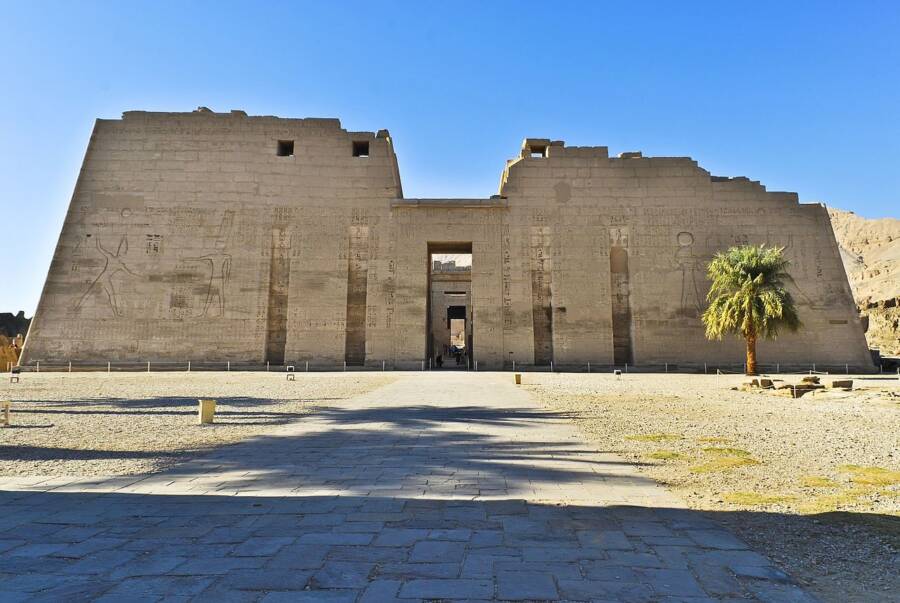
Mohammed Moussa/Wikimedia CommonsThe Temple of Ramses III at Medinet Habu in Thebes, which records the pharaoh’s triumphs over the Sea Peoples. However, his victory came at great economic cost to the Egyptians.
After this point, the Sea Peoples mostly disappear from the historical record, leaving more questions than answers. Where did they come from? Why did they leave their home territory and attack the Egyptians and other ancient societies? How come they were so effective in their attacks? And what happened to them after the reign of Ramses III?
No one knows for sure. But scholars believe that the Sea People, who harassed ancient societies for centuries, helped trigger the collapse of the Bronze Age in the 12th century B.C.E.
The Sea Peoples And The Bronze Age Collapse
In the 12th century B.C.E., a number of civilizations — including the Hittite Empire, Mycenaean kingdoms, Kassites, Ugarites, and the Amorite states — collapsed entirely. Others, including the Egyptians, Assyrians, and the Phenicians survived, but in a greatly weakened state. Some scholars believe that this stunning global collapse, which plunged the world into the “Dark Ages” was caused, in part by the Sea Peoples.
In Egypt, for example, Ramesses III drained his treasuries fighting the Sea Peoples. Elsewhere, archaeological evidence suggests that the Sea Peoples burned down entire cities. Hattusa, the ancient capital of the Hittite Empire, and Megiddo, an important city-state in Canaan, were both apparently destroyed by enemy invaders. So were port cities in Cyprus, Syria, and Palestine, as well as Greek palaces in Mycenae, Tiryns, and Pylos.
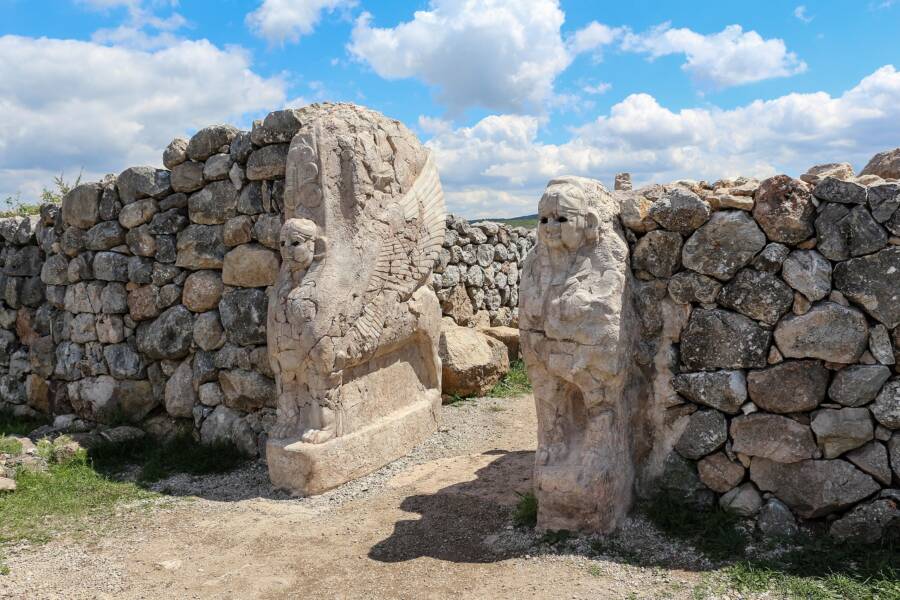
Bernard Gagnon/Wikimedia CommonsThe ruins of Hattusa, the capital of the Hittite Empire. Some believe that raids by the Sea Peoples led to the city’s destruction at the end of the Bronze Age.
“The enemy ships are already here, they have set fire to my towns and have done great damage in the country,” the king of of Ugarit wrote in a letter, apparently about the Sea Peoples. “Did not you know that all my troops were stationed in Hittite country, and that all my ships are still stationed in Lycia and have not yet returned? So that the country is abandoned to itself.”
Were the Sea Peoples the cause of this widespread destruction? Perhaps. But while they may have been one cause of the Bronze Age collapse, historians agree that the catastrophe had many factors.
From 1250 to 1100 B.C.E., the ancient world suffered from a “megadrought.” Though Egyptians and Babylonians benefited from their proximity to rivers during the dry years, people in other civilizations were forced to flee their native lands (indeed, this may have been what happened to the Sea Peoples). At the same time, between 1225 and 1175 B.C.E., the world was also rocked by a number of earthquakes.
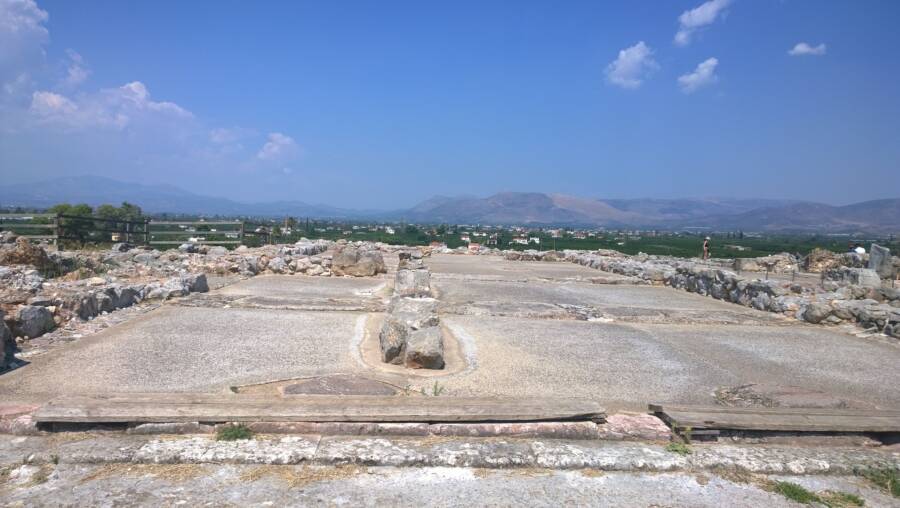
Václav Moravec/Wikimedia CommonsRuins of Tiryns, one of the Greek palaces destroyed — possibly by Sea Peoples — during the Bronze Age collapse.
This, combined with internal strife, the disruption of trade relations, and invasions — like the Sea Peoples’ — helped lead to the Bronze Age collapse. Civilizations fell, trade agreements ended, and some written languages, including ones used by the Mycenaeans and the Hittite, disappeared entirely.
From the ashes of the Bronze Age, other civilizations grew. But the Sea Peoples weren’t one of them. Maybe they were wiped out; maybe they were assimilated into other societies. But today, their fate — and their influence on the Bronze Age — remains a lingering historical mystery.
Next, discover some of the most fascinating sunken cities of the ancient world. Then, read up on the fabled lost continent of Lemuria.





